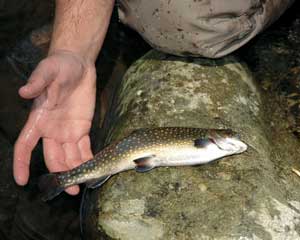
The Friday before Easter 2006 was an incredible day for outdoor activities, especially trout fishing at the creeks draining the high mountains of extreme western North Carolina.
At Robbinsville, while waiting for guide Gene Shuler to arrive, the air was a warm 81 degrees but not too uncomfortable because of the low humidity.
Shuler arrived a little after 2 p.m., and we headed northwest out of town. Soon after turning off U. S. 129 onto N.C. 143, we followed the curvy west shore of Santeetlah Lake before crossing over Big Snowbird and West Buffalo creeks en route to Santeetlah Creek.
As we ascended the mountain in Shuler’s roomy Hummer, the air was as clear as gin, almost as invigorating, and the humidity was almost too low to measure.At the bench on the mountain called Santeetlah Gap, we left the Cherohala Parkway and immediately started a steep descent down a section of the blacktop road that led to lower Santeetlah Creek and the Joyce Kilmer National Forest campground.
Looking into cloudless, blue sky, we could see the top of the mountain in the distance. Black-topped N.C. 143 appeared to be a tiny, winding blacksnake trying to reach the crest where North Carolina and Tennessee join.
One of the prominent landmarks, Stratton Bald, located near the state boundary, has an elevation of 5,345 feet.
When crossing Santeetlah Creek, which flows under the roadway through a very large culvert, we could see two fly fishermen working fast-flowing rocky pools of crystal-clear water, a picturesque scene.
We checked out a small tributary stream that flows through the Joyce Kilmer campground, but Shuler quickly decided it was too small to harbor decent-sized trout, and casting was difficult since it was overgrown with thick stands of rhododendron bushes.
As we returned to S.R. 1134, which connects with U.S. 129 six miles down the road, Shuler got a better look at lower Santeetlah Creek and beamed.
“This is a great-looking trout stream,” he said. “It’s been almost 30 years since my father brought me here to fish, and I regret that I haven’t been back until today.”
I had checked out the stream after having an early lunch at a barbecue restaurant in Robbinsville, so I knew what to expect and where he could park.
“Pull into this turn out just ahead, where you see two picnic tables,” I said. “We can park there and find out if there are any hungry trout in the nearby pools.”
Many huge rocks obstructed the flow of the swift stream, and the current had cut out a dozen or more runs and pools in the short section of the creek Shuler planned to fish near the picnic site.
“For a stream to be a good, consistent producer of trout, it needs three things: good aerated cold water, places for the trout to hide and places for them to feed,” Shuler said. “This stream appears to satisfy their basic needs.”
The several branches of Santeetlah Creek drain some of the highest mountains in the far western part of the state, and spring-fed waters are quite cold even during mid-summer’s scorching daytime temperatures.
Click here to read the rest of this story, which first appeared in the April 2007 issue of North Carolina Sportsman magazine. Be sure and subscribe so you don’t miss a single information-packed issue.




Be the first to comment